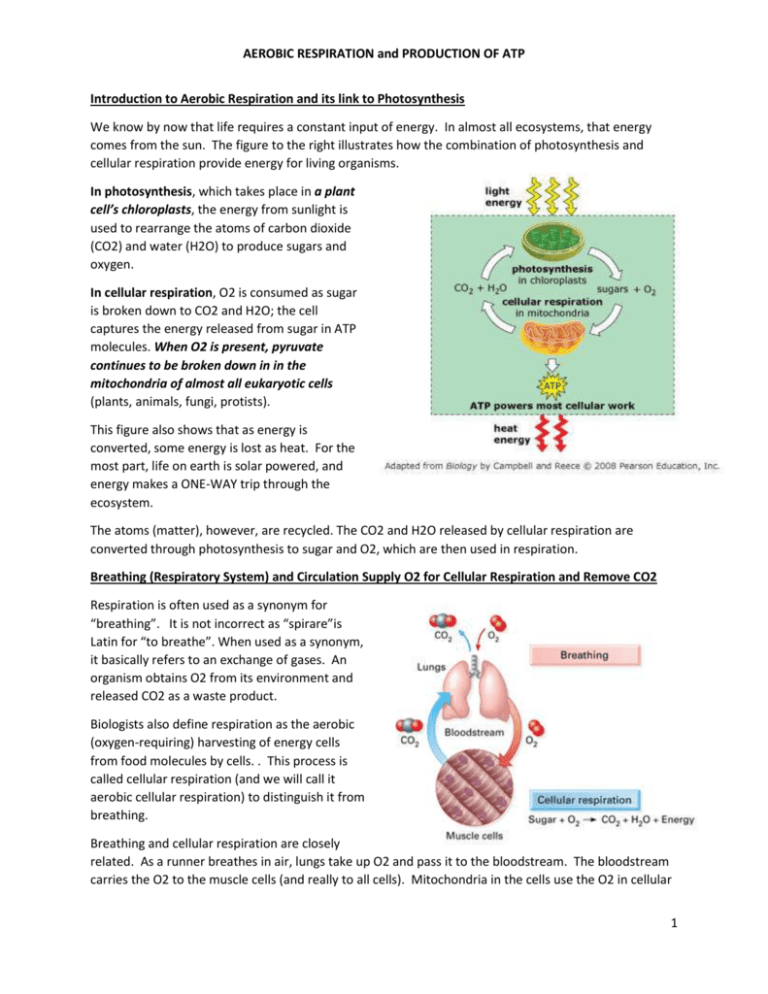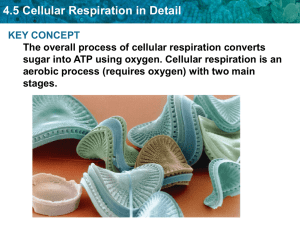AEROBIC RESPIRATION and PRODUCTION OF ATP Introduction to
advertisement

AEROBIC RESPIRATION and PRODUCTION OF ATP Introduction to Aerobic Respiration and its link to Photosynthesis We know by now that life requires a constant input of energy. In almost all ecosystems, that energy comes from the sun. The figure to the right illustrates how the combination of photosynthesis and cellular respiration provide energy for living organisms. In photosynthesis, which takes place in a plant cell’s chloroplasts, the energy from sunlight is used to rearrange the atoms of carbon dioxide (CO2) and water (H2O) to produce sugars and oxygen. In cellular respiration, O2 is consumed as sugar is broken down to CO2 and H2O; the cell captures the energy released from sugar in ATP molecules. When O2 is present, pyruvate continues to be broken down in in the mitochondria of almost all eukaryotic cells (plants, animals, fungi, protists). This figure also shows that as energy is converted, some energy is lost as heat. For the most part, life on earth is solar powered, and energy makes a ONE-WAY trip through the ecosystem. The atoms (matter), however, are recycled. The CO2 and H2O released by cellular respiration are converted through photosynthesis to sugar and O2, which are then used in respiration. Breathing (Respiratory System) and Circulation Supply O2 for Cellular Respiration and Remove CO2 Respiration is often used as a synonym for “breathing”. It is not incorrect as “spirare”is Latin for “to breathe”. When used as a synonym, it basically refers to an exchange of gases. An organism obtains O2 from its environment and released CO2 as a waste product. Biologists also define respiration as the aerobic (oxygen-requiring) harvesting of energy cells from food molecules by cells. . This process is called cellular respiration (and we will call it aerobic cellular respiration) to distinguish it from breathing. Breathing and cellular respiration are closely related. As a runner breathes in air, lungs take up O2 and pass it to the bloodstream. The bloodstream carries the O2 to the muscle cells (and really to all cells). Mitochondria in the cells use the O2 in cellular 1 AEROBIC RESPIRATION and PRODUCTION OF ATP respiration to harvest energy from glucose and other organic molecules and generate ATP. Muscle cells use ATP to fuel contractions, nerve cells use ATP for active transport, pancrease cells use ATP when producing insulin. The blood stream and lungs also perform the vital function of disposing of the CO2 waste which is produced in cellular respiration. So the “standard equation” that we see, refers to cellular respiration in the presence of O2. The Process of Cellular Respiration Banks Energy in ATP molecule So, you breathe air and eat food to supply your cells with the reactants for cellular respiration (when we use this term, unless anaerobic is used with it, the assumption is that oxygen is present). So, our equation is Glucose + 6O2 6CO2 + 6H2O ATP +Heat The simple sugar glucose is the fuel the cells use most often, although other organic molecules can also be “burned” or broken down. The equation tells us that when glucose is utilized for energy (remember, it can be stored or used to build other things) all of the atoms from the glucose are converted to waste products (CO2 and H2O) and ONLY the energy stored in the glucose bonds is used to form ATP + Pi . This means that the ADP and P molecules are present in the cell. The multiple arrows in the equation indicate there are many steps in cellular respiration. Molecules for each glucose molecule, which means about 34% of the energy originally stored in glucose is captured. The rest (66%) is released as heat. While it may seem “inefficient”, it compares well with the energy conversion of most systems (like cars and motors). Heat is not only given off as sweat, it also helps you to maintain your body temperature. The Human Body Uses Energy from ATP for all its activities Your body requires a continuous supply of energy just to stay alive – to keep your hear pumping and to keep you breathing. Your brain especially requires a HUGE amount of energy; its cells burn about 120 g (about ¼ lb of glucose) each day, and accounts for about 15% of total oxygen consumption. Maintaining brain cells and other lifesustaining activities uses as much as 75% of the energy that a person takes in as food during a typical day. Above and beyond the energy that you need for body maintenance, cellular respiration provides energy for voluntary activities (see the chart above). The energy units state calories, but as we discussed during our nutrition section, these calories are actually capital “C” Calories or kcals. The average adult needs to take in food that provides about 2200 calories per day (this does go down as you get older). 2 AEROBIC RESPIRATION and PRODUCTION OF ATP So…lets look at how your cells release the energy stored in food molecules (such as glucose) to produce the ATP required to power the work of your cells (and therefore the activities of your body). Before discussing the steps in aerobic respiration, it is important to understand how the energy is extracted from glucose. To understand this we need to spend a few paragraphs discussing redox reactions, electron carriers, and the electron transport chains. REDOX REACTIONS During cellular respiration, electrons are transferred from glucose to oxygen, releasing energy. Oxygen attracts electrons very strongly, and an electron loses energy as it moves through many reactions and is ultimately transferred to oxygen. By using many steps to transfer energy, energy can be released in small amounts, which is why ATP is created in various steps throughout aerobic respiration. The movement of electrons from one molecule to the next is an oxidation- reduction or REDOX reaction. When we look at the cellular respiration equation, you can’t really see the electron transfers. What you do see are the changes in the location of the hydrogen atoms Glucose loses hydrogen atoms (electrons) as it becomes oxidized to CO2. Simultaneously, O2 gains hydrogen atoms (electrons) as it becomes reduced to H2O. As they pass from glucose to oxygen, the electrons lose energy with each transfer. WHAT ARE ELECTRON CARRIERS? An important player in the process of getting energy out of a glucose molecule are electron carriers. In respiration, electron carriers are NAD+ NADH and FAD FADH2. Both of these molecules gain hydrogens which mean energy is transferred to them. These molecules must go through another step inside the mitochondria to form ATP. WHEN OXYGEN IS PRESENT STEP 1. Glycolysis Glucose is broken down to 2 pyruvate 2 NADH is produced in glycolysis (2 NADH) when glucose is broken down two pyruvates 2 ATP (net) are also formed. 3 AEROBIC RESPIRATION and PRODUCTION OF ATP Step 2a. Just prior to Krebs cycle (this is counted as part of the Krebs cycle) 2 Pyruvate are converted to 2 Acetyl-CoA as it enters the mitochondria 2 NADH are formed (electron carriers, contain energy) 2 CO2 are formed (waste products) Step 2b. The (Krebs Cycle) completes the oxidation of glucose 2 Acetyl CoA enters the Krebs cycle. 4 CO2 are produced 6 NADH are produced (electron carriers, contain energy) 2 ATP are produced (energy molecules) 2 FADH2 are produced We can see that the Krebs cycle makes a small amount of ATP, but most of the energy is still in electron carriers that must be converted to ATP So lets take a moment to sum up how many energy molecules we have. In Glycolysis, put in 2 ATP In Glycolysis Prep Step (2 Pyruvate 2 Acetyl CoA +2 CO2) Krebs Cycle ( 2 Acetyl CoA 4 CO2) TOTAL -2 ATP +4 ATP +2 ATP 4 ATP +2 NADH + 2 NADH + 6 NADH 10 NADH + 2 FADH 2 FADH SO… how do we get to the rest of the ATP? Step Electron Transport Chain: Oxidative Phosphorylation NADH and a related electron carrier, FADH2 (Flavin adenine dinucleotide) donate their electrons (and the energy) to an electron transport chain (ETC) embedded in the inner mitochondrial membrane. On this membrane, the energy released from NADH and FADH2 are used to create ATP. The movement of electrons concentrates hydrogen on one side of the membrane. There is a protein (ATP synthase) which permits the hydrogen ions to pass back across the membrane. The flow of ions causes the The ATP synthase spins, which allows the formation of ATP 4 AEROBIC RESPIRATION and PRODUCTION OF ATP Look at the diagram below. Identify the following: 1. 2. 3. 4. 5. Electron carriers donating electrons Concentration of H+ Flow of H+ through ATP synthase Formation of ATP Formation of water SUMMARY of EVENTS OCCURING in STEP 3. NO NADH or FADH2 are made in this step All NADH molecules (10) and FADH molecules (2) are converted to 32 ATP All Hydrogen ions and “dead electrons” are “accepted” by Oxygen H2O (which is a waste product) NAD+ and FAD+ are recycled and reused in cellular respiration. ADDING IT ALL TOGETHER If we add this amount of ATP to the net amount produced during glycolysis (2 ATP) and the 2 ATP produced in the Krebs cycle, our total net number of ATP produced during aerobic respiration is 36 ATP 5 AEROBIC RESPIRATION and PRODUCTION OF ATP QUESTIONS: 1. What is misleading about the following statement: Plant cells perform photosynthesis and animal cells perform cellular respiration 2. How is your breathing related to your cellular respiration? 3. Why are sweating and other body-cooling mechanisms necessary during vigorous exercise? 4. SHOW WORK FOR THE FOLLOWING CALCULATIONS: Consider your gender. If you eat a slice of pizza (475 Calories) , a. how long would you need to “walk briskly” to “burn off” the calories you have just eaten? ? b. How many kilometers would you have walked? c. If you ran instead, how many kilometers would you need to run? How much time? 6 AEROBIC RESPIRATION and PRODUCTION OF ATP 5. Of the three main stages of cellular respiration, which is the only one that uses oxygen? 6. For each glucose molecule processes, what are the net molecular products of glycolysis? 7. The step that converts pyruvate to acetyl CoA is often included with the Krebs cycle. If we do this, what are the net molecular products of the Krebs cycle (be sure to include ALL molecules that are produced. Place these in the correct location on the diagram below. Which carry energy? Which are electron carriers? Which are considered waste products 8. Use the diagram of the mitochondria below to label the three major steps of cellular respiration AND THEIR LOCATIONS. 9. Look at the diagram on page 4 (the one beside the electron carriers paragraph). Which molecule is being reduced? How do you know? 10. What effect would the absence of O2 have on oxidative phosphorylation? (bottom of page 5). 7









